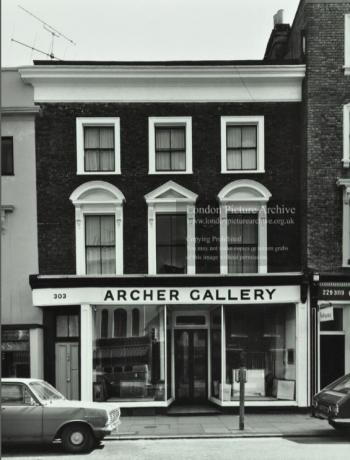Archer Gallery
Very little is known of this once well-known gallery which ran for at least thirty years at 303 Westbourne Grove, Kensington, London. I have found an obituary for the founder in The Times and I included it here.
With the passing of Dr. Ethel Ida Remfry Morris, who died in a London hospital recently, the art world has lost a familiar and well-loved figure. For many years Dr. Morris, an Australian, had run the Archer Gallery in Westbourne Grove. In all weathers, Dr. Morris, who was never seen wearing anything except a shabby man's overcoat, worked from dawn to dusk. Her gallery charged the lowest commissions in London and was non-profit making. Indeed, it ate up most of her meagre private income, and most of her friends suspected, although they could never prove it, that she seldom ate anything herself. Her preference in exhibitions was for new artists or artists showing promise and needing encouragement. This meant, inevitably, that many exhibitions were completely unprofitable, sometimes, after all the gruelling work, an exhibition would run its course without a single picture being sold. Others were an outstanding success.
Ethel Ida Remfry was born at Kew, Victoria, on June 14, 1880. Her father, a food manufacturer, disapproved of her fiercely independent spirit and feminist tendencies-a rank heresy in those days-and his rough-and-ready discipline made her determined to prove that women can equal men in many fields of achievement. Her academic career was swift and brilliant. Degrees came thick and fast at Melbourne University. In 1905 she was Master of Science and Wyselaskie Scholar, in 1911 a Bachelor of Surgery and a Bachelor of Medicine, and in the same year was Resident Medical Officer at Lady Lamington Hospital, and Lady Bowen Hospital in Brisbane. There followed years of private and hospital practice, often in remote areas, a visit to a patient often entailed a five-day journey on a donkey. She married in 1905, the Rev. William Percy French Morris late headmaster of the Church of England Grammar School and Canon of Saint John's Cathedral, Brisbane. In 1924 Dr. Morris attended a course of instruction at London University on mental deficiency. Convinced that medicine was not preventive enough, and was too often invoked too late, she felt that the best hope was in helping backward and handicapped children, and worked in the Home for Curative Education, Larkfield Hall, Maidstone. Here the theories of Dr. Rudolph Steiner were applied. and led Dr. Morris into an appreciation of the value of creative effort, such as painting, sculpture, and eurhythmics, in curing disorders of the mind, in effacing timidity and feelings of inadequacy in people, and in developing real personality. By 1937 her Australian passport no longer described her as a ‘medical practitioner’ but as ‘sculptor’. This was perfectly accurate. She proved herself a talented artist and sculptor. though fiercely disinclined to seek publicity in a way that most artists need to do nowadays if they are to have a following. She exhibited a bronze head at the 1933 exhibition of the Royal Academy. In the Second World War, she was an air raid warden in the Royal Borough of Kensington, and later owed her own life to the efforts of her colleagues. Her studio in St. Mary Abbot's Terrace was bombed, the two friends with her were killed outright, and she was buried beneath the debris for some time before she was freed. The experience left her lungs permanently damaged. Later Dr. Morris started the Archer Gallery and the rest of her life was centred and ended there.
The Archer Gallery also suffered from Hitler’s bombing, when a VI flying bomb shattered the display window. Dr Morris put in its place a huge tarpaulin and began to live inside the cold gallery to guard the pictures on show. As a result of the bombing, exacerbated her lung condition. She died on 7 November 1957. Her obituary in The Times, on 8 November 1957, described her as a well-known figure. The exact date of the Gallery's opening is not known but I feel it was c. 1939 and it certainly continued after Ethel Morris's death and exhibitions were held there into the 1970's. Who took it over I have yet to ascertain.
In its heyday, the Archer staged the first exhibitions of the Borough Group and showed individual artists including Austin Osman Spare, David Tindle, Paul Feiler, Septimus Power and many more.
Get Unlimited Access from just £5


